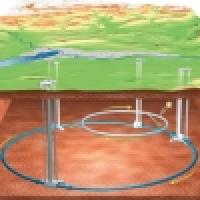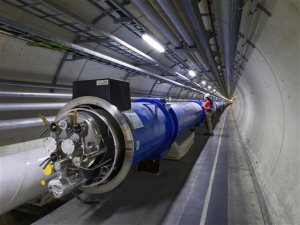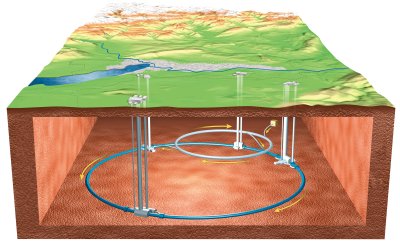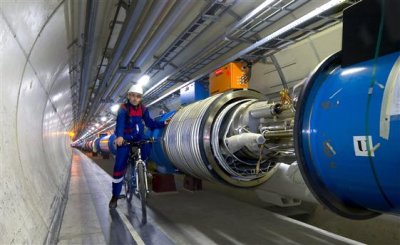
The LHC for dummies
The world's biggest physics experiment is due to kick off on September the 10th, when the European Organisation for Nuclear Research (CERN) switches on the Large Hadron Collider (LHC). Never being one to miss out on such exciting events, Plus has put together a short guide for beginners.
What is it?

A view of the LHC tunnel. Image © CERN.
The Large Hadron Collider is a particle accelerator. Basically, it's a 27km long ring-shaped tunnel made mainly of superconducting magnets which sits 100m underground. It's situated close to Geneva, on the border between France and Switzerland.
What does it do?
It accelerates particles. Two beams of particles called hadrons — these are either protons or lead ions — will be sent hurtling around the ring in opposite directions. They'll travel close to the speed of light at very high energies, and are encouraged to collide.
Why does it do it?
To answer some of the mysteries of the Universe. Physicists think that everything began around 13.7 billion years ago with the Big Bang. Back then the Universe was incredibly hot and dense. But in an instant it started to cool down and the various processes that gave rise to everything we see today sprung into action. To shed some light onto those things we don't yet understand about our Universe, it helps to look back to that first dramatic moment, to understand what ingredients went into making the world as we know it.
The high-energy collisions produced by the LHC will re-create the conditions that governed the moments just after the Big Bang. Physicists hope that the collisions will create particles, even if only for a tiny instant, that have never been observed: they are the missing links of modern physics.
So what are those mysteries?
Well, there are quite a few.
Let's start with some of the things we do know. Physicists think that all matter is made of twelve fundamental particles. These include the familiar electrons and particles that make up the other two ingredients of atoms; protons and neutrons.
The interaction of the fundamental particles is governed by four fundamental forces: the strong nuclear force, which holds quarks together to form each proton, the weak nuclear force, which causes radioactive decay, the electromagnetic force, which acts between electrically charged particles, and, of course, gravity. (The weak nuclear force and the electromagnetic force are actually just different aspects of the same force, known as the electroweak force, but we won't bother with this here.)
The forces aren't "forces" in a mysterious-magical float-around-the-ether sense. More succinctly, they should be called "interactions": what happens when a force is acting is that particles exchange carrier particles, also known as bosons. Each force comes with its own bosons, though, crucially, those belonging to gravity, called gravitons have never been observed — they are purely hypothetical.
The theory which describes what we know about the fundamental particles and forces is known as the standard model of particle physics. It performs remarkably well, but there are several hitches.
Where is everything?
There's more to the Universe than meets the eye. Observations have shown that the things we can observe — what's on our own planet and the planets, stars and galaxies in space — only make up 4% of the stuff that's out there! The rest doesn't emit any electromagnetic radiation — light — and so we can't detect it by conventional methods. We know that it exists, though, because of its effects: the celestial bodies we can observe respond to gravitational forces much greater than those accounted for by known matter, and the Universe's expansion is accelerated by some strange repulsive force.

A diagrammatic view of the LHC. Image © CERN.
Physicists blame two mysterious substances for these effects: dark matter and dark energy, believed to make up 26% and 70% of the Universe respectively. The two substances aren't made up of the fundamental particles of the standard model. Physicists have some ideas of the kind of particles dark matter might be made of, and hope that the high-energy collisions at the LHC might produce them and make them detectable.
Why are we here?
According to the standard model, each fundamental particle comes with a twin called an antiparticle, which has the same mass but opposite electric charge. When two twins meet, they annihilate each other and their mass is transformed into energy. Antiparticles originally dropped out of a mathematical equation which had one more solution than was expected. But since their theoretical conception they have actually been observed in cosmic rays and produced in laboratories.
Now the problem is this: whenever scientists have managed to produce antiparticles, they couldn't help but produce the corresponding particles in the process. If the same happened in the Big Bang, then how come things didn't just annihilate each other and vanish in a puff of energy? Where is all the antimatter? Is there something wrong with the theory? Or is there an entire Antiuniverse out there somewhere? The LHC will enable scientists to look at some of the fundamental particles and their antitwins to establish whether tiny differences might account for this apparent asymmetry of nature.
Mysterious weight gain
The theory that went into the standard model as we know it today predicts that the force-carrying particles should have no mass. Observations, however, show that this isn't true. In response to this paradox physicists have come up with a theory which asserts that, right after the Big Bang, particles were indeed massless. A little later, though, an invisible force field formed, and particles interacting with it acquired mass — they were given mass by a particular boson which came with the force field. Both the field and the boson have been named after the physicist Peter Higgs, who, together with others, came up with the idea.
The Higgs boson, alas, has never been observed. Physicists are optimistic that it might turn up, for the briefest of instants before decaying into something else, as a result of the LHC collisions, and that they might be able to detect its traces. Its detection would fix one of the biggest holes in the standard model. Any evidence for its non-existence would shake the foundations of modern physics.
Cosmic bondage
All matter is made of atoms. Atoms in turn are made of electrons, protons and neutrons. The latter two particles — not being themselves fundamental — are made of quarks. These are held together by particles called gluons. The bond is so strong that no-one has ever found quarks floating around on their own.
Right after the Big Bang, however, things would have been too hot for these strong bonds to exist. Physicists believe that instead there was a sort of primordial soup, known as the quark-gluon plasma. As it cooled down, it slowly formed the particles we know today.
The LHC will create environments of extremely high temperatures and physicists hope that these will melt the bonds between quarks and give them insight into the quark-gluon plasma and its behaviour as it cools down.
Grand unification

During construction engineers moved around the tunnel by bike. Image © CERN.
One of the biggest problems with the standard model is that the most familiar of the fundamental forces, gravity, refuses to fit in. The sub-atomic world is described by the theory of quantum mechanics, while gravity, described by Einstein's theory of general relativity, kicks in at much larger scales. The trouble is that general relativity and quantum mechanics seem to clash: when you apply the mathematics of the latter to the former, you get non-sensical answers. A grand unifying theory that alleviates the contradictions and brings general relativity and quantum mechanics together is something of a holy grail in physics.
The strongest contender for grand unification is string theory. Hailed by physicists and mathematicians for its elegance, string theory, so far, is a purely mathematical construct: it claims that the world is made of tiny vibrating strings rather than point-like particles, but no-one has ever observed such a string, and the theory hasn't been tested in any other way.
One of the most interesting predictions that drop out of the mathematics of string theory is that spacetime isn't four-dimensional, as is usually thought, but ten-dimensional. The six extra spatial dimensions, so scientists believe, are curled up so tightly that we cannot perceive them. One way to test this idea is to create high-energy environments that enable particles to jump in and out of the hidden dimensions in a way we can detect. Physicists will look very carefully at the results of the LHC experiments to see if they can find such clues.
Is it safe?
Will we be fried by cosmic rays? Sucked into LHC-produced black holes? Hoovered up by wormholes to be dumped in a parallel Universe in another time? Will the world be tipped into a state in which we can't exist? No, no, no and no. The LHC can do nothing that nature hasn't done already, and we've survived it. It isn't expected to produce any black holes, or wormholes, whatsoever, and even if it does, they'll be extremely tiny, disappear in an instant, or be completely harmless. As for vacuum bubbles in which we couldn't exist, if the LHC could create them, then so would nature, but this has never happened.
As for those people who are reportedly suing CERN for endangering humankind — well, maybe they'd be a lot happier in a parallel universe anyway.
Further reading
CERN's LHC website provides an accessible introduction and more details.
Plus has several relevant articles:
Comments
Anonymous
Will we be fried by cosmic rays? Sucked into LHC-produced back holes? I sure would want to know what a "back hole" feels like. Maybe its something like a mix between a backhoe and a black hole.
plusadmin
Ooops embarrassing 'back hole' typo corrected!
Anonymous
there is a type in one of the first paragraphs
'te' instead of the
DERRR
Marianne
Thanks for pointing that out! We have fixed it.
Topher
Lol when there is a typo (type) in a comment pointing out a typo
Anonymous
Thanks for the clear explanation for us non-physicists!
ML
Anonymous
Dear author,
Lead ions, while indeed sometimes used in the particle accelerator, are not hadrons. You may instead have mentioned neutrons along with proton, both of which are prime examples of hadrons.
Also, you may want to update your article as the Higgs Boson has essentially been "found".
Anonymous
"Physicists think that everything began around 13.7 billion years ago with the Big Bang." - I think this statement is highly offensive and inflammatory because not all who study physics agree with the theory. By writing the statement the author in turn creates the statement that those who do not believe everything began around 13.7 billion years ago with the Big Bang are not physicists. To the author, I would propose a change in this formating of the statement to include Some or the names of physicists who do.
Ian mitchell
Ok say the universe began 15 billion years , then what ? A brick wall ?
Marianne
You can find some answers to this question here: https://plus.maths.org/content/os/latestnews/jan-apr09/bigbang/index
Luke Aldingon
Interested in this one please ellaborate.
Anonymous
The photo, the very thought of CERN, frightened me down to my core which puzzles me greatly. The fear didn't make sense to me, I knew nothing about it. I contacted my sister she went online found info read and discussed it with me in the attempt to ease my fear. No, it didn't help. I still felt puzzled, how could I be so frightened. So, after months living in fear of this Monster destroy my world, I decided enough was enough I needed answers behind CERN theory what these physicists are really trying to do with CERN instead of letting my mind run wild or listening to babbling of others which would only escalate my fear. I seek knowledge online I came across" LHC FOR DUMMIES" which seemed appropriate. After reading, I feel I have little more insight of CERN, it's so exciting the thought that CERN could have the possibilities in which the physicist would find hidden dimensions by create an high-energy environment that enable particles to jump in and out then colliding together. WOW! I would love to observe the LHC up and operational I can only imagine how beautiful.
Anonymous
Thank you for providing the information. I would love to visit and watch this amazing machine in action.
Anonymous
I love to visit it's so exciting!!! A tour would be good. ❤
Justin
In Cosmic Bondage there is a misspelling in the last paragraph, it is behavior, not behaviour.
Marianne
We use British spelling
Just another Cern fan
Ever since I started to do research on Cern , it has done nothing but elevate my opinion of what we humans may be able to build towards being a sustainable species.. It is quite the Machine & what it can hopefully do for the betterment of us all.